Part III: The Town and What I Learned
[This is Part III. To Read Part I, Click Here. For Part II, Click Here.]The Town, La Alberca
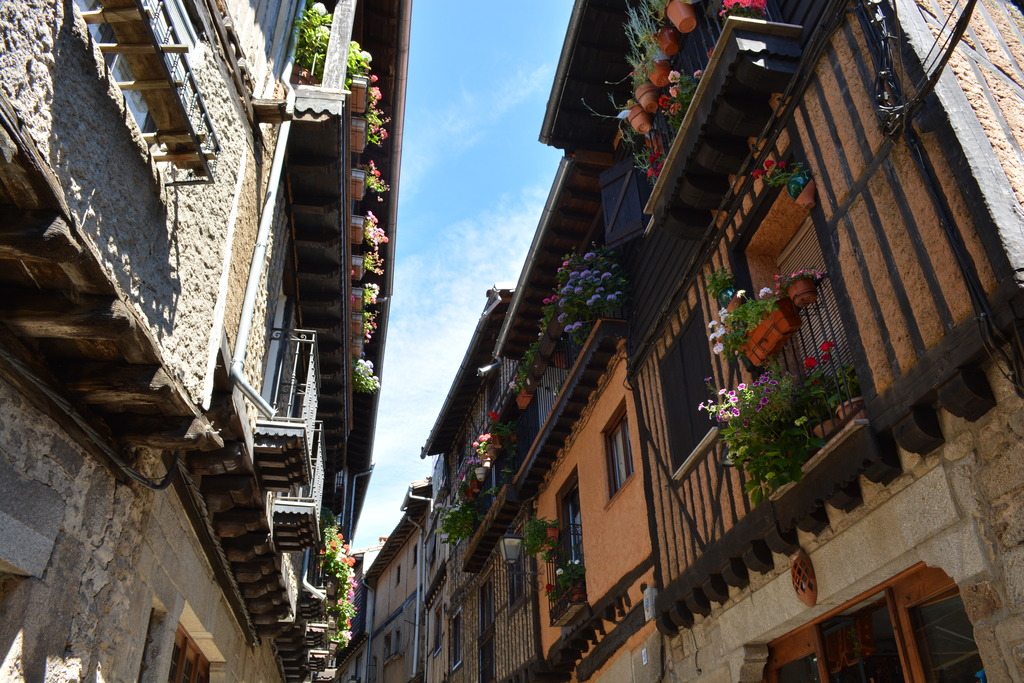
Pic by Steve Wroblews
The corridor that leads the way towards the town square from the Doña Teresa Hotel acts like a causeway into a different dimension.
The streets are extremely narrow – barely wide enough to manage one vehicle; the adjacent walkway – barely large enough for one person. So basically the width of the street plus the sidewalk was less than that of two normal-sized humans and a normal-sized Fiat.
This made it interesting when two people were walking past each other and a car was also passing. In those situations, there were a lot of Spider-Man-like acrobatics along the stone walls. It was like Ace Ventura sneaking into the shark tank room.
The narrow corridor is flanked on either side by two-story, stone buildings; the 500+ year old flats up above, clothes hanging on a line, pots of festooned flowers, while below the workshops, bakeries and stores with hundreds of hanging hams. It was something out of Rapunzel.
In fact, a few days later I would walk through this same corridor and had to stop and do a double-take: ‘Is that a man on a … Yep, that is a man riding a donkey.’
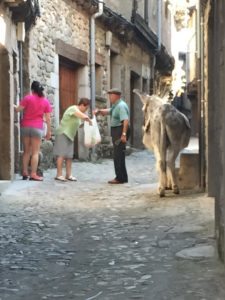
Am I in Shrek?
The man then stopped, got off, tied his donkey to a stone donkey-post of some sort, and then proceeded to barter what I would imagine was freshly churned butter and turnips in exchange for shekels(?). I half expected to see Martin Lawrence decked out in knight’s armor.
One thing I don’t recall reading in Rapunzel are the many competing smells in a place like this. It is basically a fight between the good – freshly baked bread and freshly picked cherries – and the bad – the nauseating smell of dead pig and donkey dung.
In particular, I couldn’t walk more than ten seconds through any given vein of town without being smacked in the nose by the distinct smell of raw ham.
For a vegan-aspiring Jew, this was not an ideal scenario.
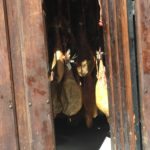
Yuck.
The first time this smell hit me, I tried to place it immediately. I looked to my right, and there, hanging from the adjacent store ceiling, were roughly 100 dead pigs –as Ace Ventura might label it – “a lovely room of death.” It was jarring to say the least.
As we continued on through the town, we passed by artisans and cobblers and farmers until we reached the town square.
THE MAIN SQUARE, PLAZA MAYOR
Now, there is no shortage of town squares in Europe – no matter the city, no matter the country. So, at first glance, there is nothing shocking about La Alberca having a principal town square. In fact, each of these “plazas” contain roughly the same features.
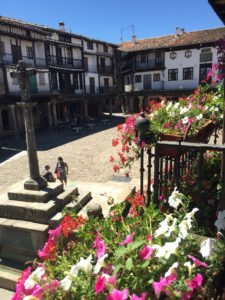
Perspective Pics: 101
Yes, they have the overpriced and not-so-good restaurants with ample outside seating. Yes, there are those stands selling over-priced nuts and knick-knacks. And yes, of course, they have the all-too-important crucifix.
However, the thing that separates La Alberca is the authenticity. The difference is in the details.
Because here – when I say “over-priced” – the wine and beer on the square each cost under four bucks. Not exactly Times Square.
And when I say “those stands” – the nuts being sold here are grown in the local area and the crafts are produced 50 feet away – not by some factory in Duluth or Shanghai. And they were made by someone who has probably been doing it all of his/her life; probably taking after his/her parents and their parents’ parents.
And when I say “those nuts and fruit are grown locally,” I don’t mean in that Michelin Star-scheming, James Beard-yearning, or hip, California “farm-to-table” way. I mean it in that – “this is what we sell and eat here because this is what we grow” way.
And when I say they have a crucifix… well, yes, yes, they have a crucifix.
The point is – the feeling you get while sipping a café con leche in this little square is one of atypical sincerity. A complete lack of guile or calculation. You look around and see mostly local vendors, municipal buildings and towns people – not a group of artful merchants looking to swindle inexperienced tourists.
THE TOWN MASCOT, LA MASCOTA DEL PUEBLO
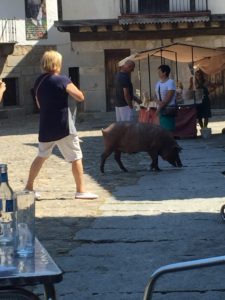
The Town Pig
Lastly, I’d be remiss if I did not point out the town mascot. That’s right, towns can have mascots (my personal fave).
Well, sort of. I mean, it isn’t a guy wearing an adult-sized pig suit at a Redskins (American) football game, giving kids high-fives and chest-bumps.
Nope – It’s an actual pig.
That’s right, a live pig — just roaming the village, walking around as it pleases. Not even a leash.
I first eyed this roaming beast while on a one-on-one with a lovely, young Catalonian teacher from a small town outside of Barcelona. We were enjoying our café solos and discussing her plan to change the way we reach kids – when this darn pig scared the crap out of me. The picture to the left is my evidence. If it’s blurry, it is because my hands were shaking…
[NOTE: do I have the courage of a small child? Probably less. But pigs are freakin’ massive and this one was just bulldozing chairs in the square. So get off my back! Ok, sorry, back to the story…]
My first thought was – this makes perfect sense.
I mean, I am in Spain. The Spanish love ham. Why shouldn’t they have a piggy town pet? Makes sense, right?
Well, that isn’t exactly the egis for this hog. It seems as though the pig came first; the ham-love second.
Quick History: This place is old [not unlike Simmons]. And back in the olden days, following the fall of the Moors (Moops?) in Spain, the new, Catholic regime didn’t take to kindly to other religions (i.e. Jews and Muslims). But they also did not want to seem like total pieces of shitaki, so they needed a tactful way to get rid of these sneaky bastards (It’s ok, I’m a Jew.)
That brought about the lovely, Jew/Muslim purging period, euphemistically named: The Spanish Inquisition.
Not as much of an inquiry as a genocide, the thesis of this scholarly little ‘investigation’ was to purge the land of the non-Jesus-people. But how?
Pop quiz, hot-shot: what do Jews and Muslims disdain and prohibit, but could also be marketed as a Spanish food (even if there was never previously any particular affection towards it)?
That’s right! HAM.
They decided to have a pig roam the city, allow it to sleep around in people’s shacks and whatnot, and eventually they could smoke out those pig-haters! Smart, right?
Of course, there was a happy ending in those days. Every January, they would slaughter the pig after a service well-done and present it to the poorest families in town. So that was nice.
Nowadays, they have taken this on as more of a money-making plot – after the slaughter, they auction it off to the highest bidder (Kinda went the other way on that one…).
But, I digress.
* * *
After having strolled leisurely through town with frequent stops, we were able to make it to the other side of town and back in only about 45 minutes — not once finding respite from the incessant ham-lead olfactory assault.
We arrived back just in time for dinner and, of course, nothing works up my appetite more than the site of gutted pigs. Not to mention the ten-course 1500-calorie “lunch” I had eaten around 4PM.
On the bright side, with my hunger sufficiently slaughtered, I was able to focus more on improving upon my train wreck of a conversation during the lunch session.
I was much more aware of the speed and complexity of my speech, more cognizant of involving the entire table in conversation, and, as a result, much more engaged. These seemingly tiny adjustments lead to a much more diverse and fruitful conversation.
At that dinner alone, we spoke about the Syrian refuges and Spain’s response, the “Camino” and how life-changing it can be, and some of our favorite countries.
That difference – from a disinterested and ‘rather elementary,’ lunch, to a complex and intense dinner conversation – was like a quick preview of how different the experience could be depending on your willingness to take the time to listen and engage.

Enjoying the square, sun, and cerveza.
After dinner, most of the elders went to bed while most of the youngsters went out for a drink. But none stayed out too long as we had a long week ahead and a 9am breakfast to attend the following morning.
So, I returned to my perfectly chilly room, got into bed, and eventually feel asleep, absolutely ecstatic about where I was and the opportunity that lay before me.
* * *
FAST FORWARD: FINAL DAY, EL ULTIMO DIA
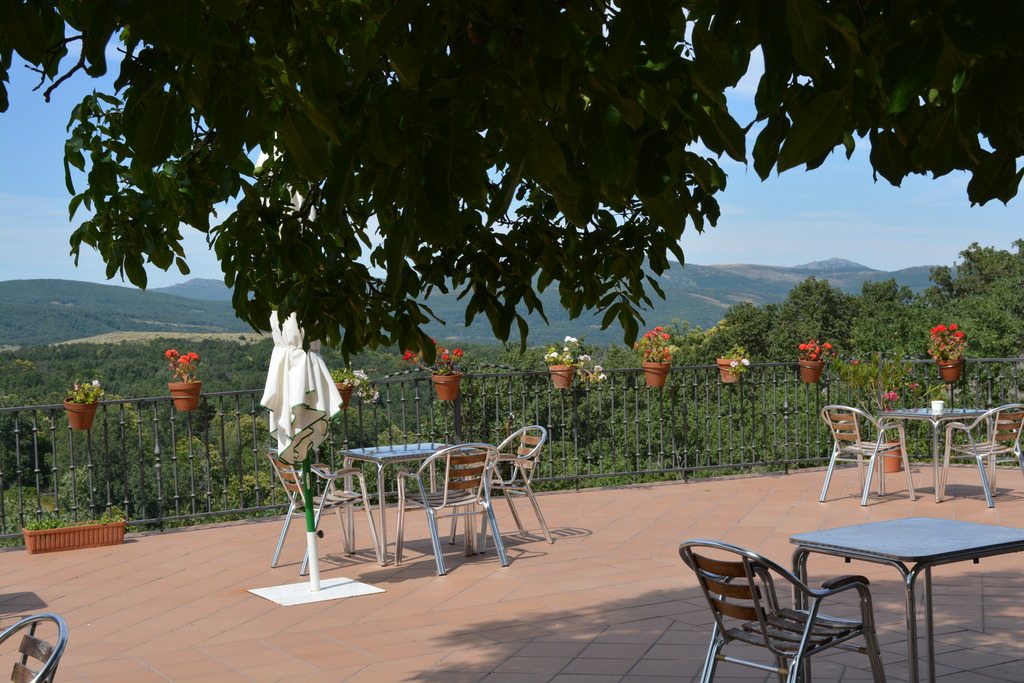
That second morning, I took an early morning jog and then sat on the patio while the sun slowly rose over the mountains. I had no idea at that point how fast this week was going to fly, but it did.
Breakfast came and went, and so did another 17 (heavy, Spanish) meals, as we all got to know one another throughout this crash-course on interpersonal communication.
Profound and unlikely bonds were formed as we all advanced past the pawns and the rooks on our respective boards; as we progressed further into the third, fourth and fifth “dates” throughout the week.
If we continue the logistical progression of the date analogy, we were all probably just about to the point of sleeping together, but I think that is where the analogy starts to derail.
The mood at that final breakfast was somewhere around that Romeo-and-Juliet-like mixture of gitty somberness. That, combined with a hungover-and-tired-ness that typically follows a night of trying to ‘fight the break of dawn.’
We participated in some last day activities, ‘thank yous,’ diplomas (seriously) and those laughs of sadness that occur when the end is imminent. Until finally it was our turn to be those people hanging on tightly to our final lunch as the next group was looking on.
The week had come full-circle: us, extremely emotional and scrambling for contacts; them, trying to force conversation with their new program-mates, wondering about the week to come, and when the hell we were going to clear out of their dining hall(!).
We finished up and thanked the staff and exchanged our contacts and smiles and tears. I was somewhat surprised by how much the emotion grabbed at my breath and throat. Breathing started to feel like sucking the strawberry milkshake through that thin, McDonald’s straw.
Sometimes, I really hate goodbyes.
When I finally mustered the strength, I got into the car of a friend from the trip; a Madrid-bound Spaniard who agreed to give me and the lovely and wise Dutch couple a ride on his way home. He was to drop us in the town of Salamanca, roughly an hour north of La Alberca.
I made a comment about how odd it was that just eight days ago, I had never met anyone in that car, and now we were talking and laughing like we had known each other for years. And hopefully, we would.
And as the car pulled away, and the Doña Teresa Hotel became smaller and smaller through the rear windshield, I could not help but think about that Kerouac quote that had grabbed me a couple years back:
“What is that feeling when you’re driving away from people and they recede on the plain till you see their specks dispersing?- it’s the too-huge world vaulting us, and it’s good-by. But we lean forward to the next crazy venture beneath the skies”
And so for me – it was on to the next one.
* * *
Reflections on Society and Literature
The feeling that I believe Kerouac was feeling at the time of writing the above – I believe it only surfaces when you leave a piece of yourself in a place.
In my life, it has felt the most lucid when there are people involved in whom I imprudently  invest my confidence, knowing that there is a departure date rapidly approaching. And yet, even as I know this, I still allow the feeling to take hold time after time, accepting the vulnerability that is inevitable with such a reckless venture.
invest my confidence, knowing that there is a departure date rapidly approaching. And yet, even as I know this, I still allow the feeling to take hold time after time, accepting the vulnerability that is inevitable with such a reckless venture.
Why? I am not sure. I guess it is one of the distinct feelings that lifts the human experience above mere consciousness. I think Psychologist Jonathan Haidt, inspired by Thomas Jefferson, probably describes this feeling the best: one of “elevation.” I kind of like that.
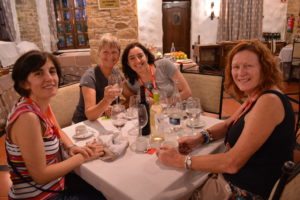 Whatever the feeling and whatever the reason for my recklessness, Diverbo was a program that certainly evoked it. Previous to this experience, I think I had certain beliefs attached to the possibility of that feeling such as: (1) we all must speak the same native language and (2) it must be attached to an experience longer than one week.
Whatever the feeling and whatever the reason for my recklessness, Diverbo was a program that certainly evoked it. Previous to this experience, I think I had certain beliefs attached to the possibility of that feeling such as: (1) we all must speak the same native language and (2) it must be attached to an experience longer than one week.
Diverbo has since shattered such beliefs.
Below are some of my other take-aways, learnings, effects and thoughts:
* * *
DIVERBO TAKEAWAYS
1. Looks Easy, Probably hard.
Pueblo Ingles was probably the only organized program I have ever been to (camps, seminars, conferences, classes, etc.) where there were seemingly zero mistakes, fights, delays, or errors whatsoever. This might make some think that running this program is extremely easy. I am not among those ‘some.’
There are examples of this all over the place. Offensive lineman, the FBI, Pilots. If nothing goes wrong, we typically don’t even pay attention to them and we assume they aren’t doing anything that difficult.
But much of what they are doing is probably anticipatory. Things that we don’t see or feel or know about — things that never even occur to us — they foresee and prevent.
I am not saying this is always true. I just think it applies to my experience at Pueblo Ingles. And that a huge benefit to this program was making me aware of that simple idea.
Again, if you are fortunate enough to have Amelia and/or Sarah as part of your staff – feel lucky – very, very lucky.
2. Listen to Understand, Not to Reply.
This is a paraphrase of Steven Covey’s admonishment in his classic book, The 7 Habits of Highly Effective People. Never has this point been made more clear to me than by Pueblo Ingles.
Many times, when you are asking a question to someone in a language in which they are not fluent, they will need time to process; time to process what you are saying to them and time to process what they want to say back to you.
While participating in PI, I noticed this stark contrast with my own learning of Spanish. One of the things I hated the most was when I was conversing with a Spanish native, and I comprehended the question, and I knew my answer, and then, as I was formulating, the person rushed me by saying it in English or re-phrasing or slowing down or something else.
This irritated me. Because they weren’t giving me time to learn. I know they were trying to help, but they actually were hurting.
And then I went and did this same thing for the first few days in PI. I’m a slow learner.
What PI taught me was: LISTEN. WAIT. LISTEN… Then, down the line, maybe talk.
Take-Away: Before you correct, suggest, or ‘help,’ – wait for this person to formulate a thought. Many times, you might not be helping.
3. Smart People, Ignorant Ears.
In the beginning of the week, I was talking really slowly and simply, enunciating all the words, etc. But, in doing so, I realized how easy it is to make the mistake of thinking that just because this person cannot comprehend English very well, that they cannot comprehend anything well.
Meanwhile, the people to whom I was speaking were far more experienced, accomplished, and probably smarter than I with respect to many areas. I mean, they were entrepreneurs, consultants, teachers, authors, nuclear plant inspectors – all with broad-sweeping interests, accomplishments and richness.
This became clearer as the week went on and the Spaniards became more comfortable and the conversations got more conceptually complex.
Keep in mind. Albert Einstein didn’t speak fluent Russian. But even when he was speaking to a Russian, he was still Albert Einstein.
Take-Away: Just because someone doesn’t understand your language all that well, does not mean they are stupid. In fact, they might be much smarter than you.
4. Ham. I still don’t like it.
* * *
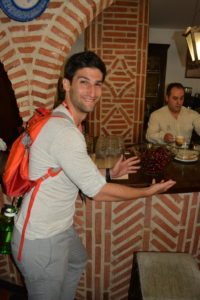
Local Cherries!
So that is my way-too-long editorial on my first Diverbo experience. If you want to get a chance to meet and speak and laugh with people from another culture and country, and also learn a thing or two about engagement, attention, listening and empathy, this program might be for you.
I am still feeling the recurring effects of the program. I still keep in touch with many of the people met on the program and with some of the Spaniards I engage in a periodical “intercambio” of language learning: a call to help each person learn the other language. We typically do a one-hour call: 30 Minutes in Spanish, 30 minutes in English.
Outside of that, I definitely plan to return to Diverbo. Maybe next time in Germany…
♦
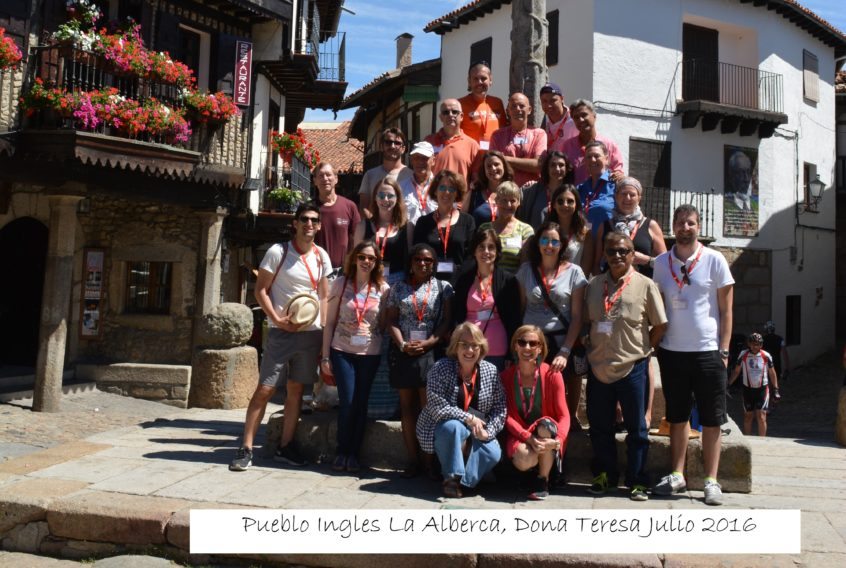


7 Comments on “Diverbo: Lessons On Listening (Part III)”
Keep writing. I need more.
Haha. Thanks. I will do my best.
I’m enjoying your writing. May I make a special request to try to add a reference from “The Sandlot”.
Request noted. I will make special effort.
In keeping with the lesson we all learned at Diverbo: “listen (in this case ‘read’) to comprehend, not to answer”, I wanted to wait until I read all three parts.
Now I can say: “Well done Justin!!!
It struck me as funny that you would call Eric and myself ‘wise’, but that must come from the fact that we still feel as if we are your age, rather than twice that. You will find that immersing yourself not just in language programs, but into life itself, that wisdom comes automatically.
Since the first part was published, I have shared it with many friends and acquaintances and I have already heard back from 3 people who have told me they want to sign up for a program! Guess you DO have to talk to Diverbo about a commission 🙂
Justin, if was not only wonderful to meet you, but what a fine job you have done in describing this life-altering experience. We’re looking forward to catching up with you and others soon.
Thanks, Antoinette. Yes, I meant “wise” in the least old way possible! I appreciate all of the kind words and the fact that you sent to friends. Hope to see you soon. Justin
What a wonderful experience you had. I loved reading about your adventures and everything you learned. The program sounds fantastic. Keep traveling and keep writing – your descriptions and photos are captivating!